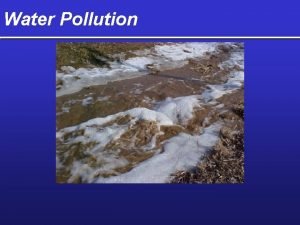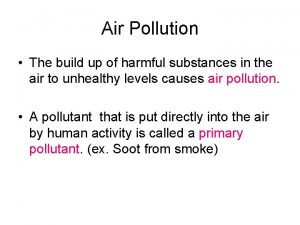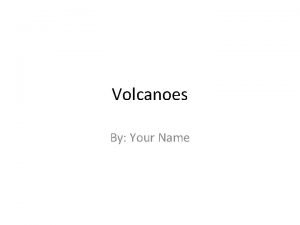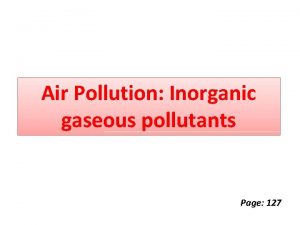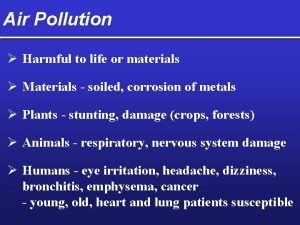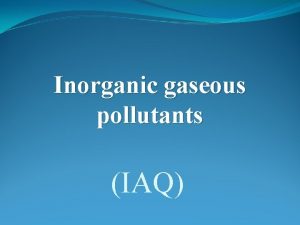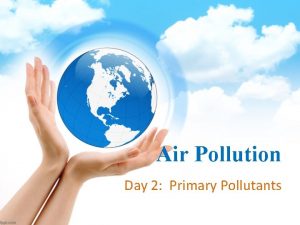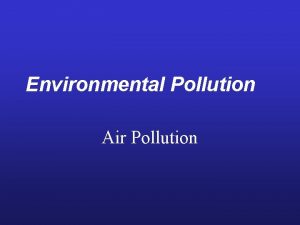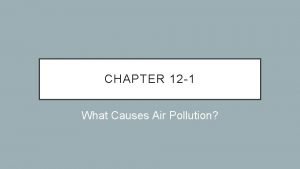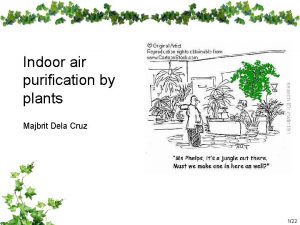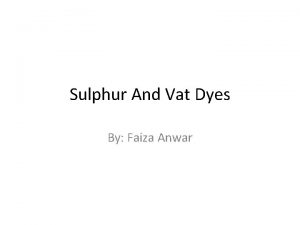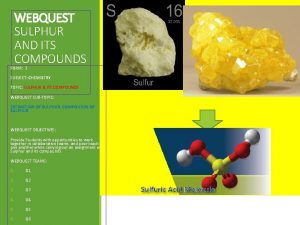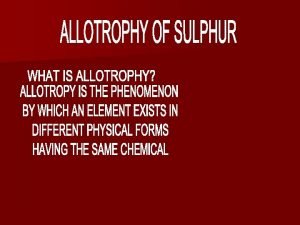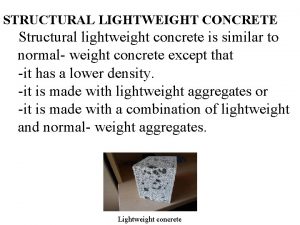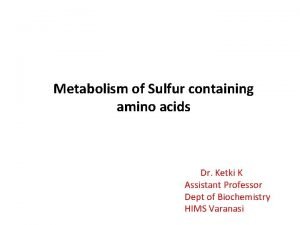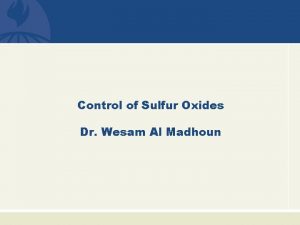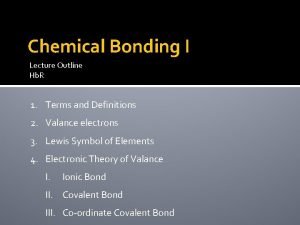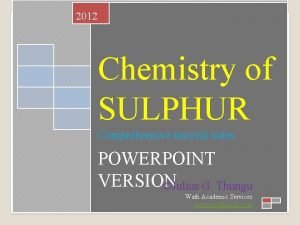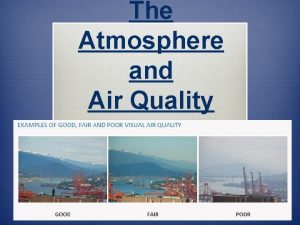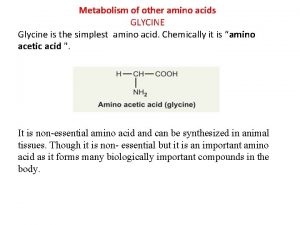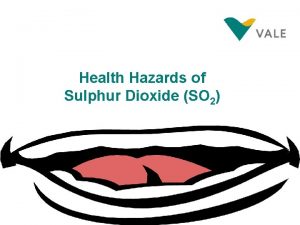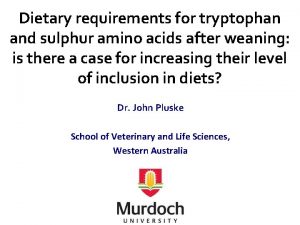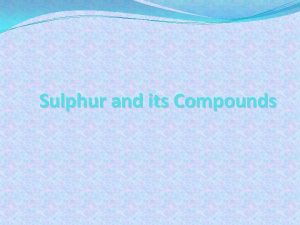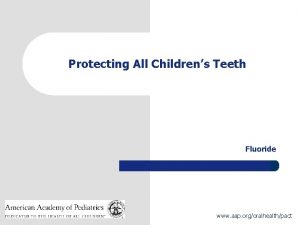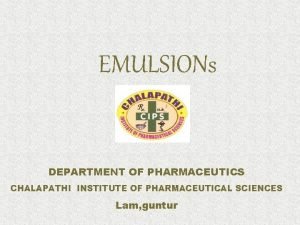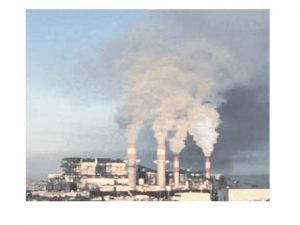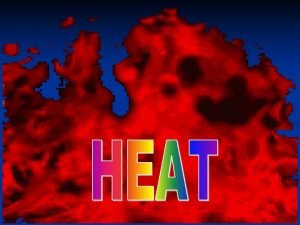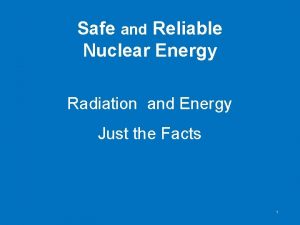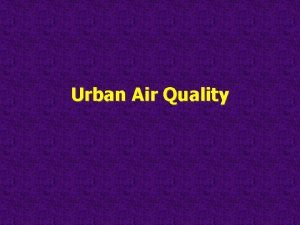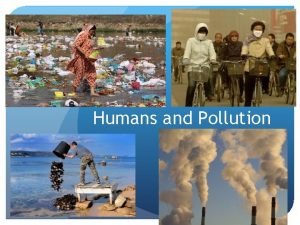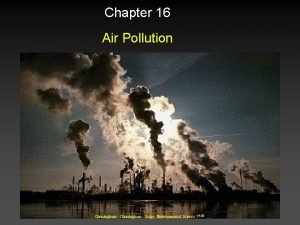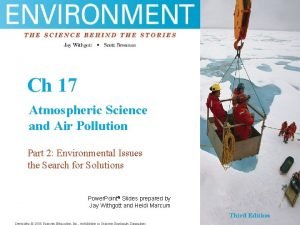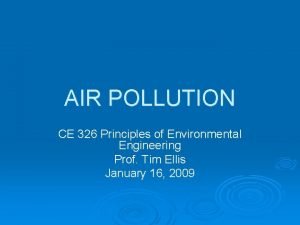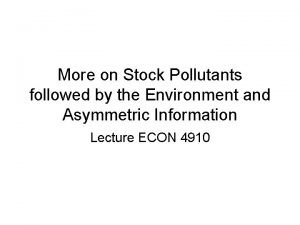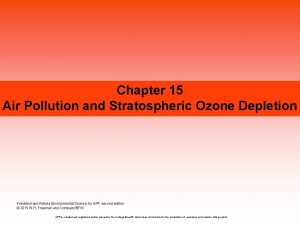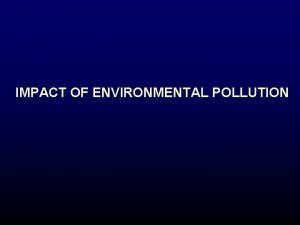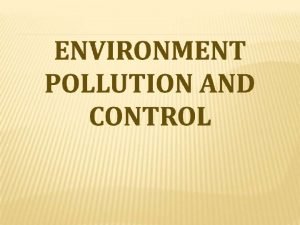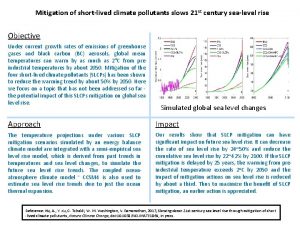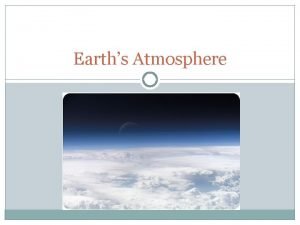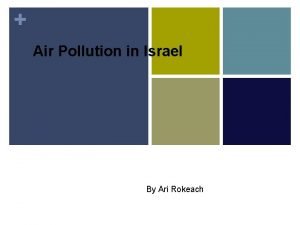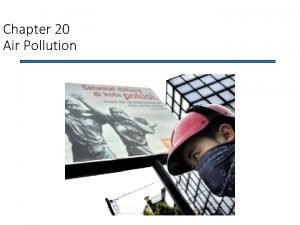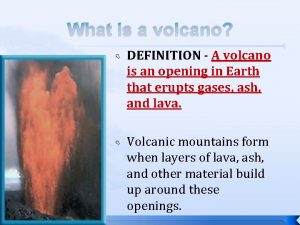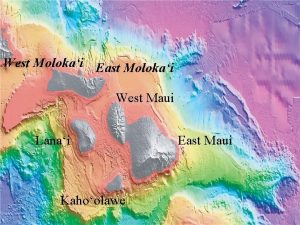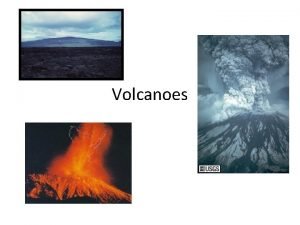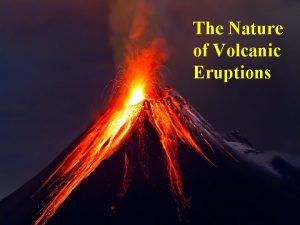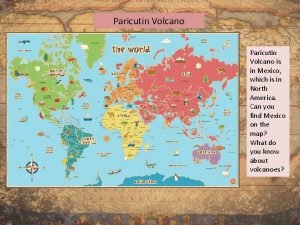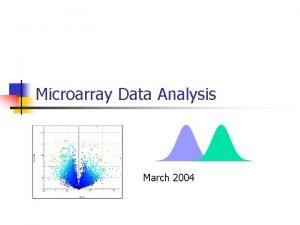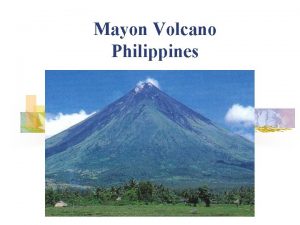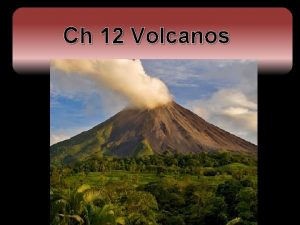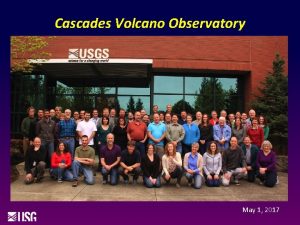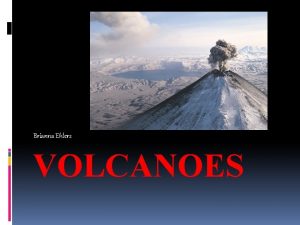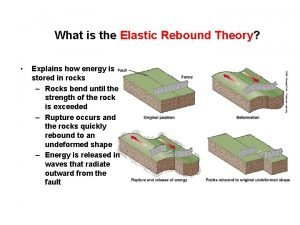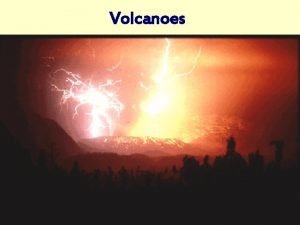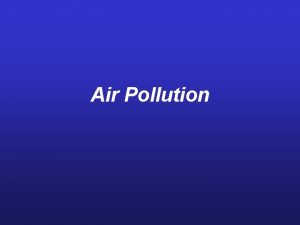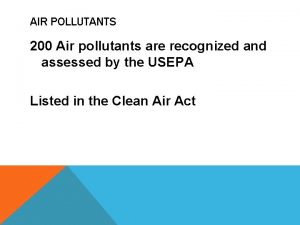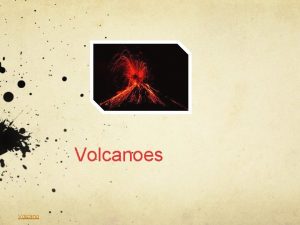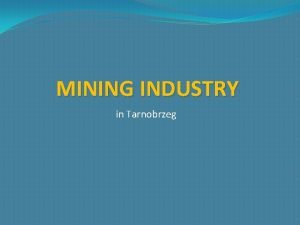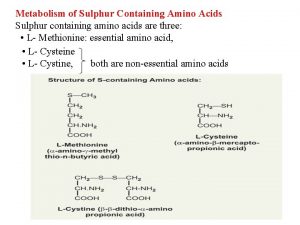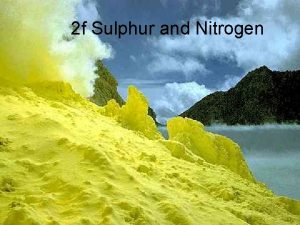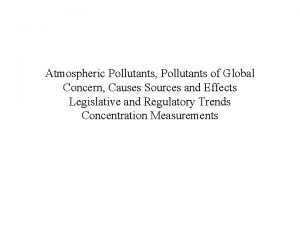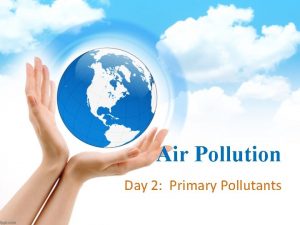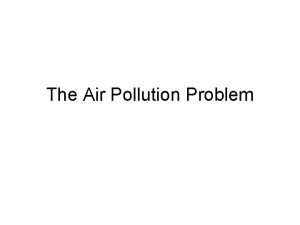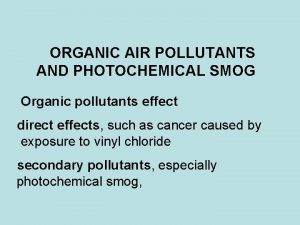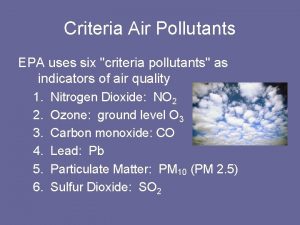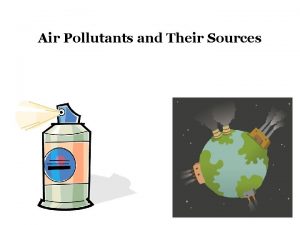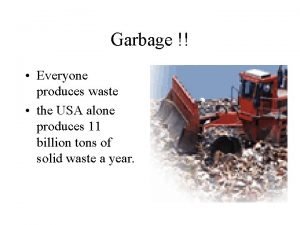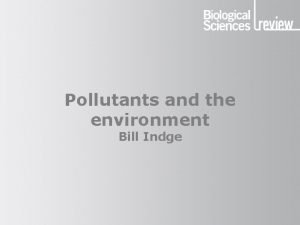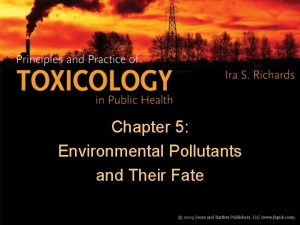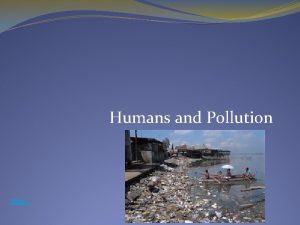Air pollutants from natural sources Volcano produces sulphur







































































- Slides: 71



Air pollutants from natural sources ~Volcano produces sulphur dioxide ~ Biological processes e. g. Digestion in cows produces large amounts of methane. Methane is an air pollutant

Air pollutants from human activities * cars burn petrol or diesel * power stations burn coal * factories burn heavy oil


Atmospheric pollutants 1. Carbon monoxide and carbon 2. Unburnt hydrocarbons 3. Sulphur dioxide 4. Oxides of nitrogen 5. Photochemical smog 6. Lead compounds and Heavy Metals 7. Particulates 8. Ozone 9. Benzene 10. 1, 3 -butadiene 11. TOMPs (Toxic Organic Micropollutants)

1. Carbon monoxide and carbon • Carbon monoxide (CO) is a toxic gas • emitted into the atmosphere by incomplete combustion processes • formed by the oxidation of hydrocarbons and other organic compounds. • survives in the atmosphere for a period of approximately 1 month • is eventually oxidized to carbon dioxide (CO 2). • Carbon particles are part of the dark smoke that forms.

• In urban areas, CO is produced almost entirely (90%) from road traffic emissions. • CO at levels found in ambient air may reduce the oxygen-carrying capacity of the blood. • Low conc. : dizzy, headache and irritable • High conc. : unconsciousness and death

2. Unburnt hydrocarbons Two main groups of hydrocarbons : volatile organic compounds (VOCs) polycyclic aromatic hydrocarbons (PAHs). VOCs : released in vehicle exhaust gases emitted by the evaporation of solvents and motor fuels. Effect: `cause cancer `formation of smog (smoke + fog)

3. Sulphur dioxide is a corrosive acid gas. Source : power stations burning fossil fuels which contain sulphur

Effect • combines with water vapour in the atmosphere to produce acid rain. SO 2(g)+H 2 O(l) H 2 SO 3(aq) Sulphurous acid • damage and destruction of vegetation and in the degradation of soils, building materials and watercourses • SO 2 in ambient air is associated with asthma and chronic bronchitis • SO 2 emissions effect air quality in both rural and urban areas • Low conc. : respiratory tracts and lung diseases • High conc. : cancer and death

4. oxides of nitrogen Nitrogen oxides ~formed during high temperature combustion processes from the oxidation of nitrogen in the air or fuel. sources: power stations, heating plants and industrial processes. The principal source of nitrogen oxides : - nitric oxide (NO) - nitrogen dioxide (NO 2)

Nitrogen oxides ~ mainly in the form of NO in the atmosphere N 2(g)+O 2(g) 2 NO(g) ~ then oxidized to NO 2 by reaction with ozone 2 NO(g)+O 2(g) 2 NO 2(g)

Effect • Irritation of respiratory tracts and lungs • Exacerbate asthma • Increase susceptibility to infections • In the presence of sunlight , it reacts with hydrocarbons to produce photochemical pollutants such as ozone. • Nitrogen oxides have a lifetime of approximately 1 day with respect to conversion to nitric acid. • Nitric acid is in turn removed from the atmosphere by direct deposition to the ground, or transfer to aqueous droplets (e. g. cloud or rainwater), thereby contributing to acid deposition.

5. Photochemical smog Sunlight acts on air pollutants ( e. g. carbon monoxide, nitrogen oxides, hydrocarbons) * form a new substance called Photochemical smog

Effect • Irritate the eyes • dangerous to people with breathing and heart problems • poisonous to plants • damages rubber, paint and other materials

6. Lead compounds and Heavy Metals Particulate metals in air come from: • fossil fuel combustion • metal processing industries • waste incineration Lead ~ is the most widely used non-ferrous metal ~ use world-wide is in the manufacture of batteries (60 -70% of total consumption of some 4 million tonnes) ~ used in paints, glazes, alloys, radiation

Tetraethyl lead • used as an additive in petrol to increase the octane number • most airborne emissions of lead from petrol-engined motor vehicles.

Effect • Lead is a cumulative poison to the Central Nervous System, particularly detrimental to the mental development of children. • Harmful effects on red blood cells, kidney, bones, brain • Heart attacks, stroke, hypertension and nervous disorder

7. Particulates PM 10 particles ~the fraction of particulate in air of very small size <10 ~ removed relatively efficiently from the air by sedimentation. ~ primary ( emitted directly into the atmosphere) ~ secondary (formed or modified in the atmosphere from condensation and growth). The atmospheric lifetime of particulate matter ~as long as 10 days for particles of about 1 mm in diameter

• creating dirt, odour and visibility problems • health effects : risk of heart and lung disease • carry surface-absorbed carcinogenic compounds into the lungs • smaller particle fraction PM 2. 5 capable of penetrating deepest into the lungs

8. Ozone (O 3) ~a secondary pollutant produced by reaction between nitrogen dioxide (NO 2), hydrocarbons and sunlight ~is photodissociated itself (split up by sunlight) to form free radicals ~ promotes the oxidation chemistry ~catalyses its own formation (i. e. . it is an autocatalyst) ~ powerful oxidizing agent

Effect • persist for several days and be transported over long distances. • irritate the eyes • air passages causing breathing difficulties • increase susceptibility to infection • is a highly reactive chemical, capable of attacking surfaces, fabrics and rubber materials • toxic to some crops, vegetation and trees.

9. Benzene ~ is an aromatic VOC. ~ is a minor constituent of petrol ( about 2% by volume) Main sources : refining, distribution and combustion of petr Effect : human carcinogenic

10. 1, 3 -butadiene ~ is a VOC emitted into the atmosphere from fuel combustion of petrol and diesel vehicles. ~ is produced by the combustion of olefins. Effect: ~ is an important chemical in potent, human certain industrial processes, carcinogenic particularly the manufacture of synthetic rubber

11. TOMPs (Toxic Organic Micropollutants) ~ produced by the incomplete combustion of fuels ~ comprise a complex range of chemicals Compounds in this category include: PAHs (Poly. Aromatic Hydrocarbons) PCBs (Poly. Chlorinated Biphenyls) Dioxins Furans Effect: carcinogenic.

• Ozone depletion • The greenhouse effect • Acid rain

The "ozone layer" is a region of relatively high ozone concentration (at about 25 km altitude) in the stratosphere, which is a layer of the atmosphere between 15 and 50 km



1. Chlorofluorocarbons (CFCs) • stable, nonflammable, low in toxicity, inexpensive to produce • uses as refrigerants, solvents, foam blowing agents, etc. 2. Chlorine-containing compounds e. g. methyl chloroform(solvent) carbon tetrachloride( an industrial chemical) 3. Halons • effective fire extinguishing agents 4. Methyl bromide • effective produce and soil fumigant All of these compounds • have long atmospheric lifetimes transported by winds into the stratosphere • release chlorine or bromine when break down



» » strong UV radiation breaks down CFC » » CFC molecule releases atomic chlorine » » one chlorine atom can destroy over 100, 000 ozone molecules

Example of ozone depletion ~ the annual ozone "hole" over Antarctica ozone levels of UVB reaching the Earth's surface Effect: • UVB causes nonmelanoma skin cancer and plays a major role in malignant melanoma development. • UVB harms some crops, plastics and other materials, and certain types of marine life. Formation and destruction of ozone • Sunlight - major energy source for both making and destroying stratospheric ozone • Up to 98% of the sun's high-energy ultraviolet light(UV-B and UV-C) are absorbed by the destruction and formation of atmospheric ozone



Halogen catalysis of ozone degredation Halogens ~ a chemical family containing fluorine, chlorine, bromine and iodine ~ catalyze ozone breakdown Halocarbon ~ carbon compound containing halogens NO, NO 2 and OH radicles ~ catalysts in ozone degredation in the troposphere and lower stratosphere

The greenhouse effect

Cause • Excessive production of CO 2 Reason • Burning a great amount of fossil fuel forests are cleared in a great rate Process • Energy from the sun falls on the earth and warms it up the earth radiates some of the heat energy back to the space • CO 2 absorbs some of the heat energy and prevents it escaping from the earth atmosphere the temperature of earth increase


Effect • Tones of polar ice melts and flow into the oceans. The level of the oceans would rise. • Low-lying areas of land would be flooded • cause severe drought in some countries

Methods to reduce the greenhouse effect • • Stop cutting down forests start new plantation stop to use or use less fossil fuel use alternative energy source such as solar energy


Acid deposition Cause : emissions of sulphur dioxide and nitrogen oxides Source: • use of coal in the production of electricity • base-metal smelting • fuel combustion in vehicles

Formation of Acids in the Atmosphere Converting NOx and SO 2 to Acids SO 2: Gas Phase SO 2(g)+H 2 O(l) H 2 SO 3(aq) sulphurous acid 2 SO 2(g)+2 H 2 O(l) 2 H 2 SO 4(aq) sulphuric acid Aqueous Phase [S(IV)] [SO 2(aq)] + [HSO 3 -] + [SO 3 2 -] This dissociation occurs by a two-fold process: 1) SO 2 (aq) H+ + HSO 32) HSO 3 - (aq) H+ + SO 3 2 -

NOx: Gas Phase 2 NO 2(g)+H 2 O(l) HNO 2(aq)+HNO 3(aq) nitrous acid and nitric acid Aqueous Phase 1. 2 NO 2(g) + H 2 O(l) 2 H+ + NO 3 - + NO 22. NO(g) + NO 2(g) + H 2 O(l) 2 H+ + 2 NO 23. 3 NO 2(g) + H 2 O(l) 2 H+ + 2 NO 3 - + NO(g)

ACID RAIN - A DEFINITION p. H of rainwater < 5. 5 p. H of normal rainwater = 5. 5 to 5. 7

EFFECT ON ARCHITECTURE - damage to limestone or marble Ca. CO+2 H+ H 2 O +CO 2 EFFECT ON TREES AND SOILS - damage the plants, change the p. H of soil EFFECT ON METALWORK - increase the corrosion rate of metals

EFFECT ON LAKES AND AQUATIC ECOSYSTEMS p. H LEVEL <6 *Basic forms of food die off. e. g. Mayflies and stoneflies are <5. 0 important food sources for fish. *Fish population die off. They can't survive. <4. 0 <5. 5 *Very different lifeforms *Fish cannot reproduce. *Young have difficulty staying alive. *More deformed adult fish due to lack of nutrients *Fish die of suffocation

Reducing SO 2 Emissions Before Combustion 1. Coal Cleaning removing pyritic sulfur (Fe. S 2) 2. Burning of Low Sulfur Coals (Subbituminous coal is of lower sulfur content than bituminous coal. ) During Combustion 1. FBC - Fluidized Bed Combustion

After Combustion 1. Wet Flue Gas Desulfurization - The wet scrubber consists of either limestone, lime, or sodium hydroxide. Ca. CO 3 + SO 2 + H 2 O + O 2 Ca. SO 3 + Ca. SO 4 + CO 2 + H 2 O 2. Dry Scrubbing - The process of dry scrubbing involves the contact between drying gas and the atomized liquid (alkaline based)

Reducing NOx Emissions During Combustion - Overfire Air After Combustion The catalytic reduction system - involves the injection of ammonia gas upstream of the catalytic reaction chamber 4 NO + 4 NH 3 + O 2 4 N 2 + 6 H 2 O 2 NO 2 + 4 NH 3 + O 2 3 N 2 + 6 H 2 O nitrogen gas is harmless

Automobiles


Eutrophication and algal blooms Phosphorus is the nutrient controlling the size of freshwater blue-green algal blooms Amount of bio-available phosphorus (orthophosphate) algal blooms

A sewage treatment plant discharge An irrigation return drain in the lower reaches, and an upland tributary, draining a semi-agricultural catchment

Eutrophication

Diagram of the interactions (sedimentation / resuspension, uptake / release) between different components of the aquatic environment and orthophosphate.

• loss of fish and shellfish EFFECT • Human health - eating clams, mussels, oysters or scallops contaminated by red tide can cause severe illness and even death to humans. • Aerosols from red tides can produce respiratory ailments • long-term consequences of inhaling potent neurotoxins from algae • release harmful toxins causing mass mortalities of various marine organisms

Organic pollution Human sewage, refuse, agricultural waste like manure of chicken and pigs and certain industrial wastes which contain large amount of organic matter 1. Self-purification of water: The water is well aerated when the amount of organic pollutants is small. They are rapidly decomposed by bacteria and fungi into simple inorganic compound. If the amount of organic pollutants is very heavy , it will remove all the dissolved oxygen and self -purification of water. In the absence of oxygen the incomplete decomposition of organic matter by anaerobic bacteria produces many unpleasant smelling gases such as methane, ammonia and hydrogen sulphides.


Red tides are caused by the explosive population growth of a minute, single-celled group of algae called dinoflagellates. 1999 Hong Kong Red Tide (Unidentified species)


Oil Millions tones of oil leak out from oil tankers. Affects: - oil floats on water. The oil layer prevent oxygen dissolving in the water. - birds lose warmth quickly when there are covered with oil

Soapy detergents(Soap) - an anionic surfactant - sodium salt or potassium salt of long chain alkanoic acids - COO- group - from animal fats and vegetable oils Soapless detergents(synthetic detergents/detergents) - sodium salt of organic acids with a very long hydrocarbon chain - SO 3 - or SO 4 - group

Common soap (hard soap) e. g. sodium stearate CH 3 -(CH 2)16 -COO- Na+ Soft soap &liquid soap e. g. potassium stearate CH 3 -(CH 2)16 -COO- K+ sodium lauryl sulphate in shampoo (soapless detergent) CH 3 -(CH 2) 11 -O-SO 3 -Na+ sodium lauryl benzenesulphonate(an alkylbenzenesulphonate) (soapless detergent) in washing powder & liquid detergent CH 3 -(CH 2) 11 -C 6 H 4 - SO 3 -Na+

AFFECT OF SOAP 1. Forms insoluble scum with Ca 2+ &Mg 2+ of hard water 2 CH 3(CH 2)16 COO-(ag) (CH 3(CH 2)16 COO-)2 Ca 2+(s) 2. forms insoluble long chain alkanoic acid 2 CH 3(CH 2)16 COO-(ag) CH 3(CH 2)16 COOH(s)

Affect of soapless detergent • Health problems- cause skin allergies e. g. p. H > 9 or < 5 • Branched hydrophobic chain are non -biodegradable • Ecological disturbance -formation of foams in rivers -prevent the breathing of aquatic lives kills aquatic lives • Phosphate additives(water softener) speed up the growth of algae

Chemical pollution Pesticides - poisonous chemicals deliberately sprayed to kill a particular organism (e. g. herbicides, fungicides and insecticides) Thermal pollution High temperature - will raise the metabolic rate and oxygen consumption of aquatic organisms - decrease the oxygen solubility in water and the resulting deoxygenation may seriously affect the aquatic organisms.

 Primary pollutants and secondary pollutants
Primary pollutants and secondary pollutants Primary pollutants and secondary pollutants
Primary pollutants and secondary pollutants What is secondary pollutant
What is secondary pollutant A dome mountain forms when _____.
A dome mountain forms when _____. Inorganic gaseous pollutants of air
Inorganic gaseous pollutants of air What is secondary pollutant
What is secondary pollutant Inorganic gaseous pollutants of air
Inorganic gaseous pollutants of air What are the secondary air pollutants
What are the secondary air pollutants Major air pollutants
Major air pollutants Air pollutants
Air pollutants Indoor air pollutants
Indoor air pollutants Air higroskopis air kapiler dan air gravitasi
Air higroskopis air kapiler dan air gravitasi Print sources of information
Print sources of information Water management importance
Water management importance Aeries parent portal sulphur springs
Aeries parent portal sulphur springs Difference between sulphur and vat dyes
Difference between sulphur and vat dyes Potassium cycle
Potassium cycle Sulphur and its compounds klb notes
Sulphur and its compounds klb notes Milk sulphur
Milk sulphur Sulphur impregnated concrete
Sulphur impregnated concrete Sisd tyler parent portal
Sisd tyler parent portal Importance of sulphur containing amino acids
Importance of sulphur containing amino acids Importance of sulphur containing amino acids
Importance of sulphur containing amino acids Control of sulphur dioxide
Control of sulphur dioxide Sulphur dioxide lewis structure
Sulphur dioxide lewis structure Soulable sulphide analysis presentation
Soulable sulphide analysis presentation Ozone composition
Ozone composition Sulphur containing amino acid
Sulphur containing amino acid Photo of sulphur
Photo of sulphur Photo of sulphur
Photo of sulphur So2br2
So2br2 Natural sources of heat
Natural sources of heat Indeks fluorosis dean
Indeks fluorosis dean Natural emulsifying agent obtained from vegetable source
Natural emulsifying agent obtained from vegetable source Formation of nitrogen dioxide
Formation of nitrogen dioxide Natural source of heat energy
Natural source of heat energy Does seaweed contain nitrogen
Does seaweed contain nitrogen Sources of radiation
Sources of radiation Secondary pollutants examples
Secondary pollutants examples What are secondary pollutants
What are secondary pollutants Primary vs secondary pollution
Primary vs secondary pollution Ozone layer depletion
Ozone layer depletion Primary vs secondary pollutants
Primary vs secondary pollutants Stock pollutants
Stock pollutants Primary and secondary pollutants difference
Primary and secondary pollutants difference The meaning of environmental pollution
The meaning of environmental pollution Before and after global warming
Before and after global warming Short lived climate pollutants
Short lived climate pollutants Why do thermal inversion layers trap pollutants
Why do thermal inversion layers trap pollutants Ari rokeach
Ari rokeach Sources of smog
Sources of smog Define mobile sources of air pollution
Define mobile sources of air pollution Natural hazards vs natural disasters
Natural hazards vs natural disasters Natural capital
Natural capital Oil natural air forced
Oil natural air forced Where did the term volcano come from
Where did the term volcano come from Broad volcano
Broad volcano East
East Which volcano
Which volcano Big island size broad slightly domed volcano
Big island size broad slightly domed volcano Broad gently sloping volcano
Broad gently sloping volcano Paricutin volcano facts
Paricutin volcano facts P value formula
P value formula Characteristics of mayon volcano
Characteristics of mayon volcano Volcano introduction
Volcano introduction Morfologi dasar laut
Morfologi dasar laut Steep sided volcano made of loosely packed tephra
Steep sided volcano made of loosely packed tephra Cascade volcano observatory
Cascade volcano observatory Cylinder cone volcano
Cylinder cone volcano Notes from a volcano
Notes from a volcano Explain the elastic rebound theory
Explain the elastic rebound theory Big island size broad slightly domed volcano
Big island size broad slightly domed volcano
